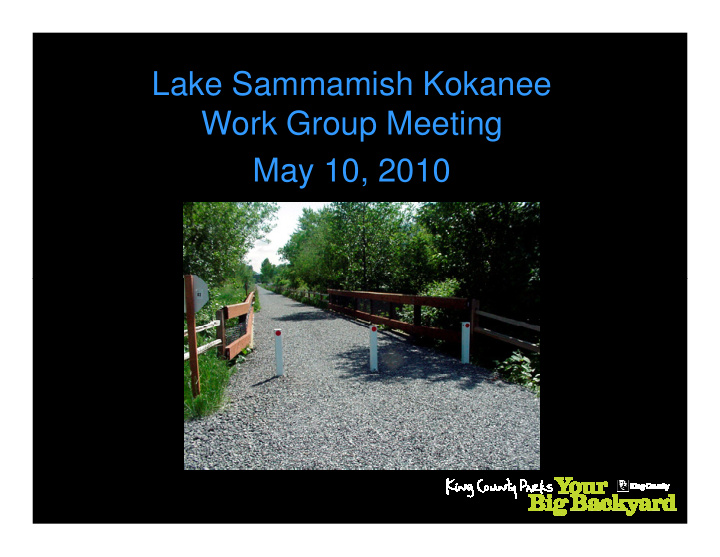



Lake Sammamish Kokanee Work Group Meeting May 10, 2010
Project Overview • The purpose of the project is to design and construct an alternative non-motorized transportation corridor and multi-use recreational trail from Gilman Boulevard in Issaquah to the Bear Creek Trail in Redmond. • An existing gravel trail encompasses the former railbed through most of the corridor. The gravel trail varies in width from 8-12 feet. • The new trail would be wider and paved. Amenities such as restrooms and parking will be added at SE 33 rd St, Inglewood Hill Rd, and NE 70 th St.
Typical Trail Section
Project Schedule and Phasing • Final Environmental Impact Statement (combined NEPA/SEPA) for entire corridor will be issued in May. • Permitting, design, and construction are being completed in phases, as funding becomes available. – Construction of segments in Redmond and Issaquah may begin in 2011. – Design of segments in Sammamish will not likely commence until 2011 or 2012.
Project Implications on Streams • The trail crosses 46 streams. • Most of these streams pass beneath the trail via culverts. The trail crosses a few via bridge. • As the gravel trail is widened: – Some of the culverts require lengthening or replacement, resulting in a loss of stream channel. – The associated stream buffers are affected.
Design Approach • Avoid and minimize impacts • Apply a screening and prioritization tool to determine where to propose fish passage improvements improvements • Identify potential locations for mitigation
Fish Passage Screening and Prioritization • STEP 1: Identify affected culverts • STEP 2: Identify streams affected by culvert lengthening or replacement • STEP 3: Identify fish habitat and fish-bearing streams • STEP 4: Perform fish barrier analysis • STEP 5: Determine engineering feasibility
Culvert Screening Results
Planned Fish Passage Improvements • 7 culverts on fish-bearing streams do not meet fish passage requirements. • Physical constraints limit upgrade feasibility at 4 of these crossings. at 4 of these crossings. • 3 culverts planned for upgrade, including George Davis Creek
ELST Mitigation Considerations • Mitigation may be required for culverts where fish-passage upgrades are infeasible or for riparian impacts • Coordination with Kokanee Work Group • Coordination with Kokanee Work Group • Other constraints and considerations -Timing constraints -Mitigation size and location -Compatibility with kokanee restoration
High Priority Streams for Kokanee Conservation • Currently contain spawning populations: – Ebright Creek, – Laughing Jacobs Creek, – Pine Lake Creek, and – Pine Lake Creek, and – Issaquah Creek • Having historical usage – Zaccuse Creek – George Davis Creek
Recommend
More recommend